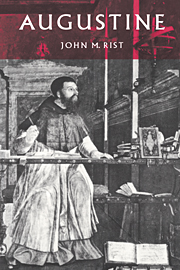Book contents
- Frontmatter
- Contents
- Acknowledgements
- List of Abbreviations
- Works of Augustine
- Notes on chronology
- Bibliographical note
- 1 Approaching Augustine
- 2 Words, signs and things
- 3 Certainty, belief and understanding
- 4 Soul, body and personal identity
- 5 Will, love and right action
- 6 Individuals, social institutions and political life
- 7 Evil, justice and divine omnipotence
- 8 Augustinus redivivus
- Appendix 1 Porphyry's Account of the Sentence in the De-Magistro
- Appendix 2 Traducianism, creationism and the transmission of original sin
- Appendix 3 Augustine and Julian: aspects of the debate about sexual concupiscentia
- Index of modern authors
- General index
Appendix 3 - Augustine and Julian: aspects of the debate about sexual concupiscentia
Published online by Cambridge University Press: 22 September 2009
- Frontmatter
- Contents
- Acknowledgements
- List of Abbreviations
- Works of Augustine
- Notes on chronology
- Bibliographical note
- 1 Approaching Augustine
- 2 Words, signs and things
- 3 Certainty, belief and understanding
- 4 Soul, body and personal identity
- 5 Will, love and right action
- 6 Individuals, social institutions and political life
- 7 Evil, justice and divine omnipotence
- 8 Augustinus redivivus
- Appendix 1 Porphyry's Account of the Sentence in the De-Magistro
- Appendix 2 Traducianism, creationism and the transmission of original sin
- Appendix 3 Augustine and Julian: aspects of the debate about sexual concupiscentia
- Index of modern authors
- General index
Summary
In 419, or a little later, Julian attempted to pin a charge of Manichaeanism on Augustine, claiming, among other things, that Augustine's account of sexuality in marriage implied that the marriage act is vicious in itself. For Augustine had insisted from as early as The Desserts of Sinners (1.29.57) that the ‘disobedient members’ indicate original sin and the birth of children ‘in concupiscence’ (2.4.4).
The ensuing argument, still unfinished when Augustine's death prevented the completion of the last work Against Julian, was partly provoked by Augustine's use of the word concupiscentia itself. As we have seen, what he meant to represent by this term, at least in the phrase concupiscentia carnis, was a generalized weakness of the ‘flesh’, to which we can improperly assent. But ‘misunderstanding’ arose from the fact that, though concupiscentia is not limited to sexual desire, autonomous sexual arousal, being its most obvious visible effect, conveniently served as a symbolic representation of the phenomenon as a whole.
Augustine's assessment of the origin of this general weakness, which he saw as a defect, not a sin, and which in its sexual form makes males look like animals, is that it is acquired as a penal result of the fall. According to Julian, however, Augustine's ‘real’ view is that sexual desire is sinful in itself, not merely that it is vitiated by the sinfulness of Adam. Against this rendering of Augustine's position, Julian offered his own alternative, that libido as presently experienced is to be described as a morally neutral ‘natural appetite’ (Marriage and Concupiscence 2.7.17, apparently only in men (Against Julian 5.5.23)), or as ‘vigour of the members’ (2.35.59).
Information
- Type
- Chapter
- Information
- AugustineAncient Thought Baptized, pp. 321 - 327Publisher: Cambridge University PressPrint publication year: 1994
